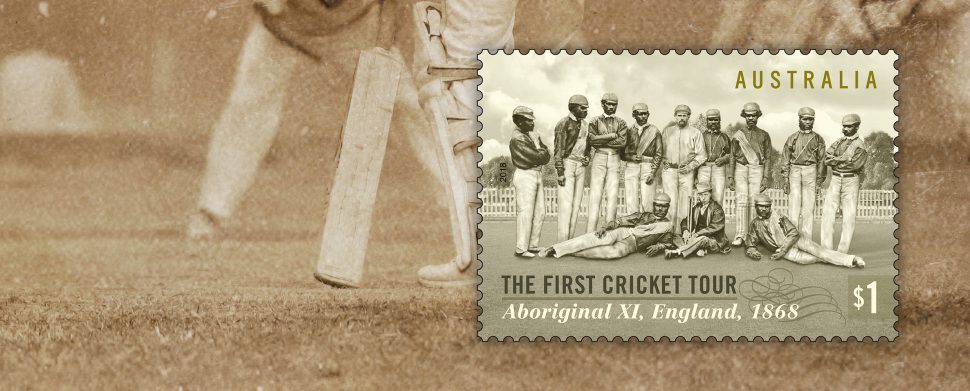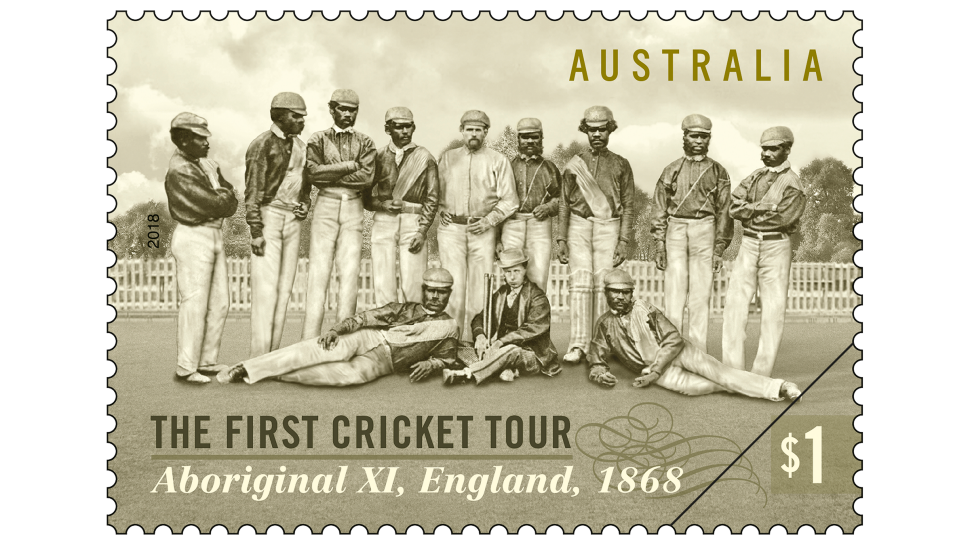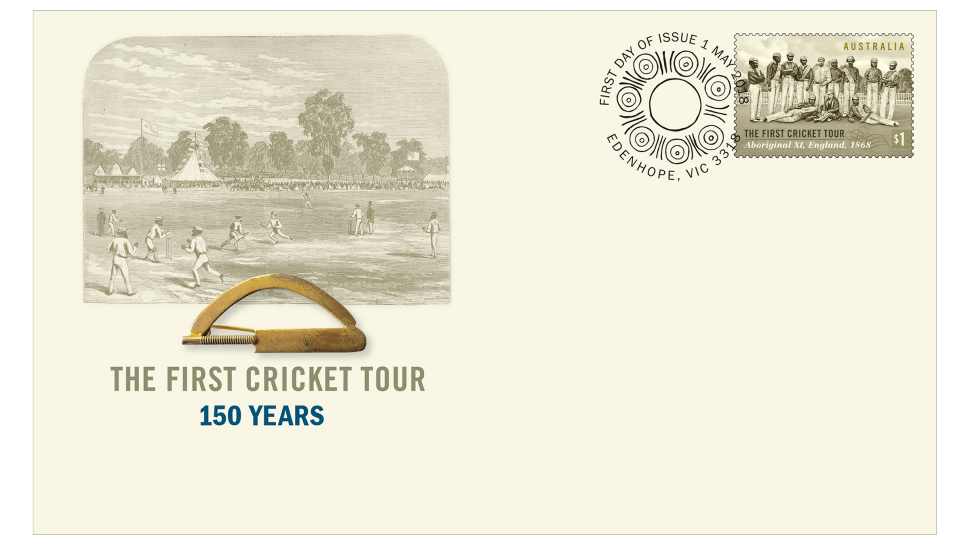“I think we should cast our mind back to the 1868 side – the first Australian side that toured England – the Aboriginal side … if they hadn't been so successful and if they hadn't endured those hardships, it may not have been easy, so easy for those that have followed.” Ian Chappell, 2003
The First Cricket Tour: 150 Years stamp issue, released on 1 May 2018, commemorates the first international cricket tour by a team from Australia, which occurred 150 years ago in 1868. The 1868 tour of England was undertaken by a team of 13 Aboriginal cricketers, most of whom were Jardwadjali, Gunditjmara and Wotjobaluk men from the Western District of Victoria. Several of these men had also played in the historic 1866 Boxing Day match between an Aboriginal XI and the Melbourne Cricket Club (MCC), held at the Melbourne Cricket Ground (MCG). The response to this match is said to have inspired the idea of a tour of England.
| THE 1868 ABORIGINAL XI |
|
|---|---|
Bullocky (Bullchanach) |
Mosquito (James Couzens) (Grougarrong) |
Charley Dumas (Pripumuarraman) |
Peter (Arrahmunijarrimun) |
Dick-a-Dick (Yangendyinanyuk) |
Red Cap (Brimbunyah) |
| Jim Crow (Lytejerbillijun) |
Sundown (Ballrinjarrimin) |
| Johnny Cuzens (Zellanach) |
Tiger (Bonnibarngeet) |
| Johnny Mullagh (Unaarrimin) |
Twopenny (Jarrawuk/Murrumgunarrimin) |
| King Cole (Bripumyarrimin) |
Captain: Charles Lawrence |
After arriving in England, the Aboriginal XI played 47 matches against county and local teams, between May and October 1868, including a match against the viscounts and earls of Marylebone Cricket Club on the hallowed turf at Lord’s, where Johnny Mullagh (Unaarrimin) top-scored with 75. The results were impressive: the Aboriginal XI won 14, drew 19 and lost 14 of their matches. The schedule, however, was a gruelling one: King Cole (Bripumyarrimin) contracted a fatal case of tuberculosis during the tour, and Sundown (Ballrinjarrimin) and Jim Crow (Lytejerbillijun) returned home soon after. The remaining 11 players (pictured on the stamp with their tour manager) not only managed to continue playing but also equalled the overall performance of their UK opponents on the tour.
What is also incredible is the fact that this tour was conducted at a time when international cricket touring was a rarity. The only previous international tours were by English sides: one tour to the United States and Canada in 1859, and two to Australia, in 1861–62 and 1863–64.
During the tour, much of the English press reporting was positive. The team were praised for their enthusiasm and sportsmanship and, in the case of stand-out players like Johnny Mullagh and Johnny Cuzens (Zellanach), for their highly impressive cricket skills. Mullagh played 45 of the 47 matches of the tour, scoring almost 1,700 runs and high-scoring against Reading with 94. He also took almost 250 wickets.
Also popular with spectators and the press were the team’s cultural displays. These were essentially an adaptation of the displays of athletic skill carried out during the lunch break at English cricket matches. Dick-a-Dick (Yangendyinanyuk), for example, starred at the curved wooden club (known as leowell or langeel), with which he used impressively deflect cricket balls. Yangendyinanyuk played as a middle order batsman, sometimes opening the batting and contributing to the bowling and wicket-keeping efforts of the team.
Yangendyinanyuk was great- great grandfather to Richard Kennedy, who was of much assistance to the researcher working on the stamp issue. From historical documents, Richard has been able to highlight the conditions for Aboriginal people at the time of the tour and piece together some of Yangendyinanyuk’s early life:
“This was a time of turmoil for Indigenous people, due to their conflict with European settlers. Traditional food sources were being wiped out and so they started to use the new sources of food brought in by the settlers. It was also a time when the government introduced the Protectorate Act, giving them power to place Aboriginal people on mission reserves. Some of the more independent Indigenous people started to work on the stations to provide food for their families and others were sent to local mission reserves such as Ebenezer. My great-great grandfather worked on the Mt Elgin station. Around 1864, the settlers at the stations in the area started to play cricket against each other. The players noticed the Aboriginal people watching and throwing balls back, so they were asked to join in,” says Richard.
“It was also in 1864 that my great- great grandfather was involved with locating the three Duff children who were lost in the bush, 30 miles from Horsham on the Spring Hill station. The name “Dick-a-Dick” came from the settlers, who could not understand the language. It was used, along with the name “King Richard”, as recognition of him finding the Duff children,” adds Richard.
“My feeling is that he probably would have relished the opportunity to do what he did on that tour. It also meant he was able to show his skills with his traditional tools,” says Richard.
The 1868 team was captained and mentored by English professional cricketer Charles Lawrence, whose connections helped secure the fixture. Charles Lawrence started playing cricket when he was 17 years old. Charles played for many teams, including Middlesex and Surrey, the World XI, Scotland and Ireland. In fact, he founded the All Ireland XI.
Ian Friend, the great-great-grandson of Charles Lawrence, also assisted the researcher for this stamp issue.
“In 1861 Charles was selected to be in the All England XI, which was the first team to tour Australia. This tour was a great success. After the tour, Charles was asked to return to Australia and take up a position of professional coach of New South Wales ... At the time bowling in Australia was still mainly underarm, so a lot of coaching was need to improve the game,” says Ian.
Charles Lawrence knew Tom Wills, as the two had played a couple of games together in Ireland. Tom Wills had taken an Aboriginal XI to Sydney in 1866, and Charles Lawrence was impressed with their athletic ability. In 1867, Charles Lawrence was asked by W R Hayman to captain and coach an all Aboriginal XI to tour England. Lawrence travelled to Lake Wallace, Edenhope, in the Western District, and trained the local players for two months, before he selected a side to tour England. (There had been a previous yet unsuccessful attempt to tour of England by would-be financier WEB Gurnett.)
Upon their return to Australia, most of the Aboriginal XI returned to station life. Increased restrictions made it difficult for them to continue playing cricket. And indeed, Yangendyinanyuk returned to his station and, later on, back to the Ebenezer Mission. It is believed he is buried there. The difficulty in determining this for certain is that many Aboriginal people had their names changed by white settlers, sometimes even resulting in different surnames between siblings. This is the case between brothers on the tour Johnny Cuzens and James Couzens, for example.
“Charles Lawrence returned to normal life after the tour, working as clerk on the railways, though he continued to play cricket. He was employed by the MCC to coach the juniors at 70 years of age. He died at the age of 88. In his death notice he was referred to as the “Father of Cricket Tours”, which is a fitting description for all he achieved in his cricket life,” says Ian.
Twopenny (Murrumgunarrimin) and Charley Dumas (Pripumuarraman) played an inter-colonial match for New South Wales. Cuzens and Mullagh played professional cricket briefly for the Melbourne Cricket Club, but decided to return home. Johnny Mullagh played for Victoria at the MCG, where he top-scored against a touring English XI, and he starred in regional competitions, playing with the Harrow Cricket Club until his death in 1891.
Ian Friend has an impressive collection of Charles Lawrence’s tour memorabilia. The ‘boomerang and bat’ cap pin that features in the design of the first day cover from this issue, for example, is from this collection. The boomerang featured on the sheetlet pack was used on the tour and is from the collection of Royal Albert Memorial Museum, and the inside of the sheetlet pack includes a page from the original scorebook, from the collection of the Hamilton Gallery.
In 2002, the Aboriginal XI was posthumously recognised in the Sport Australia Hall of Fame as the first cricket team from Australia to tour England. In 2004, each player was assigned an official Cricket Australia number “… to recognise their place in Australia’s cricketing history.” Ian Friend, along with Richard Kennedy, had much to do with advocating for this much-deserved accolade.
“The moment was chilling when the Hall of Fame team was announced. Everybody stood and applauded; the noise was thunderous. I did think at the time the players would have been extremely happy and proud. Now to be honoured with a stamp is another significant recognition of this celebrated team from 150 years ago. We all should be very proud of their achievements,” says Ian.
Richard Kennedy echoes this pride: “I believe that this team would be the greatest team ever to tour. They started to play an ‘alien’ game in 1864 and four years later, they tackled the English in their national sport and drew with them.”
“I am thankful to Australia Post for the honour they have bestowed upon them. Every member of the team deserved to be recognised and honoured for their deeds,” adds Richard.
The First Cricket Tour: 150 Years stamp issue is available from 1 May 2018, online, at participating Post Offices and via mail order on 1800 331 794, while stocks last.
Walkabout Wickets: from artwork to postmark
View the gallery and technical details from this issue
This content was produced at the time of the stamp issue release date and will not be updated.




